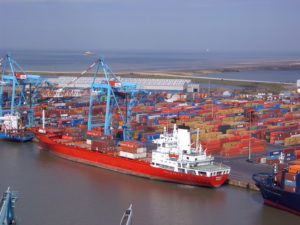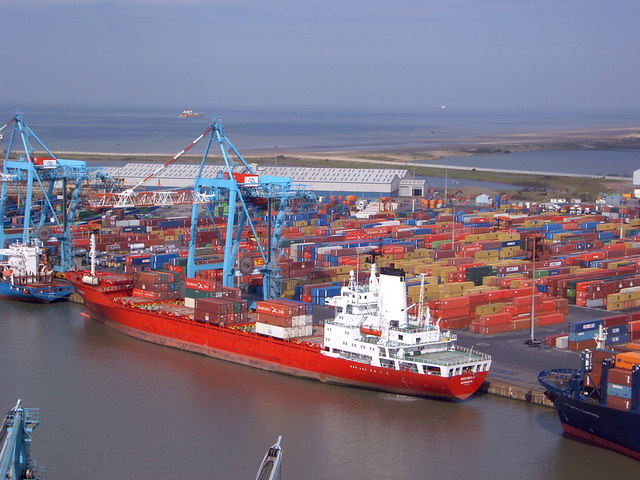 The container shipping industry just can’t seem to catch a break as the overall market environment in the early months of 2016 continues to be difficult, marked by sluggish demand, huge variations among trades, and plunging freight rates, according to a new analysis by the Baltic and International Maritime Council (Bimco).
The container shipping industry just can’t seem to catch a break as the overall market environment in the early months of 2016 continues to be difficult, marked by sluggish demand, huge variations among trades, and plunging freight rates, according to a new analysis by the Baltic and International Maritime Council (Bimco).
In addition, all numbers were impacted by the Chinese New Year, which disrupts most trade figures for the first months of any year.
On the trans-Pacific, the U.S. East Coast showed an increase in imports volume of 6.5%, a significant rise even above the strong level seen in 2015, said Bimco. The West Coast imports of loaded containers were only impressive compared to the very poor volumes seen in 2015, a year marred by conflict between labor and management.
Meanwhile, volumes going into Europe from Asia dropped 6.8% in January-February 2016 from the year before. Bimco noted that this was not just due to a drop in transshipment volumes to Russia but also to continued weak demand from mainland Europe. In 2015, volumes transported from Asia to Europe fell by 3.6%, of which volumes going specifically to Russia dropped by 24.2%.
Globally, head-haul TEU miles were down 1.2% in January-February 2016 compared to the year before. This drop in demand for container shipping was also reflected in freight rates on all container routes out of Shanghai covered by the Shanghai Shipping Exchange.
Nearly all of the head-haul freight rates sat at their lowest levels on record by mid-April. Both trades going to U.S. East Coast and West Coast were 50% below a six-year average for April.
For Shanghai to Europe it was slightly worse. The exceptions were to destinations in East Japan and Santos, where rates were above the 2015 level but still below the six-year average.
Moreover, time charter rates seemed to have reached their lowest possible level. Only a very few charters exceed six months in duration, a clear sign of how bad the market was, said Bimco.
“No one commits to a longer term under current market conditions. ‘Bid and ask spreads’ for longer term time charters are simply too wide, a huge change in that market over the past year,” it continued.
On the supply side, the delivery of new container ship capacity, as well as the recycling of superfluous ships, exceeded expectations slightly in 2016. About 240,730 TEUs were delivered into the fleet in the first quarter, whereas 105,509 TEUs left it. The net growth of the fleet in Q1 was 0.7%. For the full year, Bimco expects 3.4%, slightly up from its January estimate.
On new contracting activity, no orders have been agreed in 2016.
“This is the first time since Q2-2009 that three months have passed without any new orders signed. The lack of orders reflects the very poor market conditions and the fact that 2015 saw 2.2 million TEU being ordered,” said the organization.
Last year, 119 ships with a 10,000+ TEU capacity accounted for 87% of the total new capacity being ordered. The other 118 ships ordered, ranging in size from 1,000 TEUs to 5,300 TEUs, accounted for only 13%.
This year, the average container ship size for delivered ships is going down from the all-time high of 7,952 TEUs in 2015 to around 7,000 TEUs per ship.
A major development for the industry is lower bunker fuel prices, which has encouraged some liner companies to sail the longer route and avoid the costly canal tariffs in the Suez Canal, said the council.
In turn, the Suez Canal has made an unprecedented move—offering 30% discounts to container ships sailing from the U.S. East Coast back to Asia. This is a good turn of events for the Panama Canal, which will be opening up its new locks for business shortly.
“For the shipping industry, this is a very positive move, as canal transit is normally very costly. The opening of the new set of locks in Panama means more competition for Asia-U.S. East Coast trades—something that we could hope would drive down canal transit fees,” said Bimco.
Moving forward, it said the road to recovery lies in managing capacity by the individual companies in the industry. “As demand is not expected to grow at a pace needed to match the capacity of new ships entering the fleet, extensive idling of the modern and efficient ships in the fleet and continued demolition of the inefficient ships will improve the market both in the short and mid-term.”
Photo: Carl Davies





